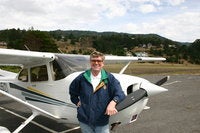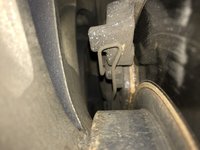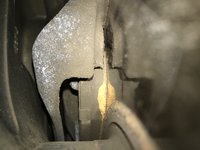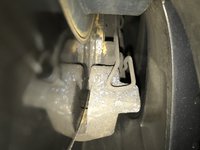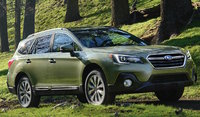I have a 2015 Outback that needs the rear brake pads replaced- the problem is that the fronts are still at 75%, while rears are around 5%.,,,,,,
Asked by Bonjoevee Apr 10, 2017 at 10:02 PM about the 2015 Subaru Outback 2.5i
Question type: Maintenance & Repair
So that leads me to my questions....1) what could be causing such uneven
wear? and 2) my mechanic friend was a little stymied by the integrated
ebrake design on the rears and didn't want to change them before doing
some research...do you know of any "how to" sites on the interweb for this
year Subie?--youtube's got nuthin'. Thanks so much!
45 Answers
That is not normal. The rears typically last far longer than the fronts. Since your is probably still under warranty I would have a talk with your Subaru dealer. Is the e-brake dragging?
How many miles on the pads?
56k. To the best of my understanding- the electronic e-brake is either all on or all off, so there shouldn't be an instance where it would drag. I suspect that it may be a caliper issue, though. This is my sister's car, so I only drove it for a few minutes- but the one thing i noticed was the sensation that it wasn't "free wheeling" when I put it into drive- seemed a little sluggish when at an idle.
TheSubaruGuruBoston answered 7 years ago
Can't be a DOUBLE caliper issue unless you tend to get struck by lightning a lot.
I have the exact same issue with my '15 Outback. Rear brakes are worn and the front is still fine. We do haul heavier loads and even sometimes tow a small trailer but it still doesn't seem right. 76k miles. If learned anything, please share.
TheSubaruGuruBoston answered 6 years ago
Rear pads are really small, and with the newest (2010+) OBs seem to wear faster than the fronts. I'm replacing rears on '13-14 OBs, so yours seems a bit premature; sounds like you've a heavy brake or live on a hill?
Mccarthyp2 answered 6 years ago
I have a 2015 legacy with 100k miles and the rear pads need replacing (front are fine). I have 2 VW Jettas and the rear pads wear out much quicker than the front. It seems to be normal.
I am having the same issue on a 2015 Legacy 2.5i. 45,000 miles. Rear pads are down t0 5% but the fronts are fine. Found out when car had the brake fluid replaced. The mechanic had no idea what could be causing the uneven wear. My other question is do the rotors need to be replaced as well or can I just replace the pads?
TheSubaruGuruBoston answered 6 years ago
How do the rotors look? If very clean on the contact surfaces certainly don't bother to replace them, as they generally last 3-4 winters here in the northeast, for example. Slapping in pads will take you barely a half hour. This premature wear is still a mystery. I'm replacing rusty rear rotors 'n pads on a pair of 2014 OBs this week, but indeed the fronts are fine. Not sure if 2015-2018 are identical to 2010-2014 predecessors. BTW, if you DIY you'll need only 14mm socket, waterpump pliers, some spray-grease, and maybe a flat screwdriver. You should have zero chance of caliper slider issues at this young age.
I have the same issue with my Subaru outback 2015, rear brakes 80% down and fronts only 30%. When I come out of a stop and drive I feel the brakes make a thumping noise but it goes away. The service claims its normal and then said it was'nt unusual wear and tear so my vehicle coverage will not cover it . I think they know what the problem is they just wont say
Same here -- on my wife's 2014 Outback and my son's 2015 Legacy. Mileage on both is in mid-60,000s. Both have rear brakes in last 10%. Fronts are fine. My independent mechanic is hesitant to work on them. Says the ABS sensors on are prone to breakage when they go back in. He's recommending we go to the dealer.
TheSubaruGuruBoston answered 6 years ago
S/he is being way too wary, as there's no reason to disturb the ABS sensors when pulling the rotors off. But if the rotors are still pretty clean (try to check the INNER surfaces too) just slap in pads...but don't expect to get more than another winter or two at best from the rotors. Rotors for 2015+ are bigger and still pricier, but 2010-2014 are cheap, and thus not worth reusing. While you're back there with your 2015 I'd add the 19/20mm OE thicker rear anti-swaybar to dramatically improve handling and body control, as it's a cheap ($125) mod that really works, restoring chassis dynamics to the decent 2013-2014 level. But this is another thread....
This is not uncommon on AWD cars that the rears wear faster then the fronts. The rear pads are significantly small in thickness then the fronts. Usually you will wear the rears 2 to 1 to the fronts. There is no need to replace the rotors provided they are not scored, warped or glazed, then you should replace them
TheSubaruGuruBoston answered 6 years ago
Well...not really. The job of rear brakes is to keep the vehicle straight as deceleration occurs when weight transfers forward onto the front brakes...where all the "work" is done in heat absorption by the double-thick rotors. The predominant reason the rears can "wear" first, especially in the rust belt, is that their rotors rot first because of lack of wind drying them AND that, yes, the pads are small to begin with. But sometimes folks replace them early because they look thin, when they actually can last a long time IF the rotors are clean. So it's a funny dance we do, especially up here in salt country.
So I have a 2016 Forester with 40000 kms or 25000 miles which my mechanic says only has 4 mm of pad left. Is this normal? Do they need changing at this point? I've never had a car need brakes changed this soon. Does the warranty cover brakes? Thanks!
TheSubaruGuruBoston answered 6 years ago
Yes. No. Not brake pads. 4mm is HALF the original, you have at least another yea remaining.
I found its typical for 2015 Subaru Outback rear pads to wear faster than the front due to the brake proportioning control valve. This valve shifts the braking to the rear brakes to reduce forward acceleration during a hard stop and prevents brake lock up. This new technology maintains CG balance when stopping.
TheSubaruGuruBoston answered 5 years ago
"reduce forward acceleration during a hard stop"? Surely your high school physics teacher is weeping.
MuhNameAJeff answered 5 years ago
I found this the same case for my 2016 Legacy. Almost 40k. My mom borrowed my car for couple days and complaining the brake pads are thin as she feels it when driving. So I took a picture of the pads to see how "thin" they are. Interestingly I found the rear pads are much thinner than the fronts. I took 4 picture of each of the pads. Well... seems the forum only allow me to post 1 picture per post. So here is one of the rear pads.
MuhNameAJeff answered 5 years ago
And here is one of the front pads. I checked the brake fluid too. They are not clean but as well not dark that needs a replacement and the fluid is full. I believe they(dealer) did a brake fluid flush when at 30k maintenance. So I wouldn't say it's the brake fluid causing any uneven wear.
MuhNameAJeff answered 5 years ago
As you can see one of my rear rotor is not that clean and has some scratches there. But the pads are even as I'm posting the picture of the other one here... Looks like the pads can last 1 more year and I'm planing to change both the rotor and pads next year.
Subaru Ambassador answered 5 years ago
E-Brakes on the Gen 4 and Gen 5 Outback are entirely unrelated. So is hill-holder. The Gen 4 and Gen 5 Outbacks employ a dual brake system in the rear. Driving brakes are disc brakes. E-Brake and hill hold are drum brakes inside the rotor.
Subaru Ambassador answered 5 years ago
TheSubaruGuruBoston, no, alas, this place didn't let me tag and respond where I thought it did, which was to these comments: Answer 1: "Is the e-brake dragging?" Answer 3: "To the best of my understanding- the electronic e-brake is either all on or all off, so there shouldn't be an instance where it would drag." The e-brake is irrelevant, as I noted.
I believe the early wear is a design tolerance error. My crv did it and now my Forrester. I think the shoes that are too tight in the clips can't move away from the disk when pressure is released. I clean out the clip slots under the clips with a file and put some grease on it. Then I grind down the ends of the new shoes until they slide easier into the clip grooves, I grease those also, not much, don't want any grease on the linings or disk. That seems to solve it for me.
TheSubaruGuruBoston answered 5 years ago
That would be the case if only ONE pad was worn much more than the others, as statistics would dictate that the odds of all four pads wearing prematurely due to sticking is just too great...but not impossible. The reason the rears wear faster is that the pads are too SMALL...and in salty-winter states the rotors don't adequately dry. Mean life is 2-3 winters, vs 3-4 up front. Not a big deal. Seems that only some German offerings have bigger rotors and meatier pads for longer life.
Subaruboston, If my guess is correct regarding pad fit being the problem and caused by design tolerance then the magnitude of the error should predict how many pads would be involved in any given vehicle. I could be wrong of course. My experience with the crv is curious and indicates a potential system design flaw, or maybe a materials issue? The pads that fit tightly in the clips wear out first, in my experience. In my 2017 Forrester 2.5i the left rear outboard pad lining was gone at 44k miles. The other pads had 40+% lining remaining and they were not uniform but higher wear seemed evident based on how tightly they fit. I gave all the new pads the same treatment because I'm not sure what is going on. If it is rust or debris build up under the clips then it could happen to any pad.
myapples101 answered 5 years ago
my local car guy says he can replace the rear brakes and rotors. 2016 outback with 51,200 miles. do i have to worry about damage to the electronic e-brake? i over heard the two mechanics talking bout it and asking each other if something special needed to be done with it? should i be worried they may damage it ?
Can you put deco brakes and rotors (front and back) or do you have to use genuine subaru outback brakes for a 2013 2.5 .
Replaced my Forester pads at 82,000 miles. The fronts had more life left than the rears but not by a lot.
TheSubaruGuruBoston answered 5 years ago
XB6PS: Any parts that cross-reference correctly should work fine.
I have a 2016 Subaru Legacy with 29,150 miles. The rear left caliper froze. The caliper is being replaced but they say my rear pads only have 2mm left and need to be replaced, both sides are the same. I don't understand 1. why the rears are worn before the fronts, 2. why the brakes are so worn after 29.1K miles in the first place. I've never had brakes on a new car go before 40k miles.
Rear brakes have much smaller pads than the front, in an approximation to equal axial wear. Subaru goofed, so the fronts wear first. Note that brake pad wear is STRICTLY related to stopping, not mileage, so it's easy so understand how one can wear rear pads in three years of city driving. OTOH I have 2016 OBs with 80k highway still running well on original pads. In the past Subie pads usually lasted as long in the salty states as the rotors, but the 2015+ OB/Legs have beefier vented rear rotors that seem to be good for 4 winters...IF the pads last that long! Pads are like shoelaces in that it's the number of times you use them that determines their lifespans, NOT miles walked.
Austaurean answered 4 years ago
I have 80k on my 2015 Subaru Outback 2.5.. Had a time based (87500/42m) service 3 months ago and new pads not required at that time, they had some brake test that they completed and they said everything was great. Pad change wasn't even mentioned as a probable to do for the next service in Feb 2020.
TheSubaruGuruBoston answered 4 years ago
Rear rotor corrosion in the rust belt combines with thin pads to accelerate wear. Does your moniker mean your a Texan?
The 2015 Outback uses the rear brakes a lot with the anti-dive feature. Additionally, the cruise control will use the rears to slow down if the car is going to fast. Lastly, if you use X- Mode or the brakes will wear faster as well.
TheSubaruGuruBoston answered 4 years ago
Yup. It'd be better if the rear pads were either thicker or a bit larger in surface area. Fortunately the rotors are bigger, and vented, so if kept un-rusted they can last through two sets of pads, as we're finding out as time flies. I'm now looking at clean rear rotors with thin pads, and able to simply replace the pads and expect another 2-3 years (winters) service. And NO, don't unplug the rear e-brake module, as all hell will occur with the ABS et al systems!
Found alot of miss information in this thread. Just to clear some things up -- pads at the front tend to be larger in the front than in the rear, Subaru uses a braking strategy know as EDS which is part of the ABS system which puts most of the braking force on the rear brakes causing them to wear faster (realistically depending on how you drive you can expect brake pads to last between 25k - 100k miles, while they provide better braking forces they do not last as long as drum brakes), If you have a Subaru with an electronic parking brake I suggest you have the dealership do the brakes as most local shops have no experience working with that system, lastly your local mechanic (or yourself if you have a micrometer) can measure your rotor thickenss and overall surface quality to determine if you will need rotors or not.
TheSubaruGuruBoston answered 4 years ago
Yet replacing rear brakes is EASILY within DIY handyperson wheelhouse, as well any decent mechanic, as only unplugging one sensor is required; absolutely no need to use pricey dealer service NOR measure rotor thickness, as they never wear thin enough to be a problem, as they're now thick vented stock. Relax....
HoosierDaddy2 answered 3 years ago
Both of my Subarus wear the rear pads faster than the fronts, 2010 Legacy, 2015 Outback.Each has over 100k mi on the clock right now. I'm just chalking it up as normal at this point. They work flawlessly until the squealer tabs start their squealing. RE: "reduce forward acceleration during a hard stop"? Surely your high school physics teacher is weeping. In plain language, I was taught that any change in velocity is "acceleration", so yes, even slowing down is a form of acceleration by that definition. Per Google, the physics version of acceleration differs from street language: "In mechanics, acceleration is the rate of change of the velocity of an object with respect to time."
TheSubaruGuruBoston answered 3 years ago
Of course, but the common lingo for negative acceleration is "deceleration". Again, rear pads are thin, so wear quicker...especially in salty states where the rear rotors scrape 'em more.
